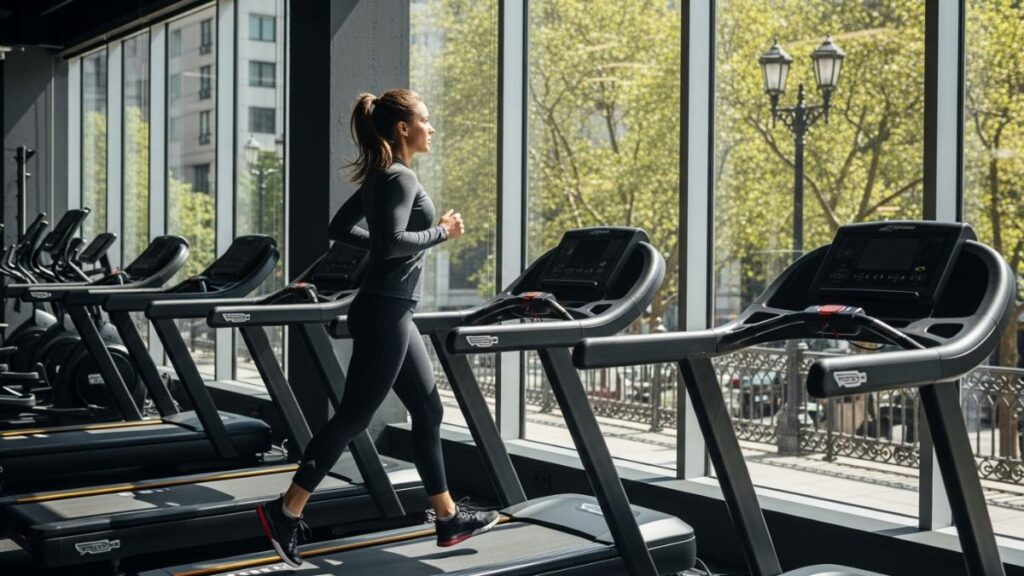
Understanding Treadmill Pace Conversion
What Treadmill Pace Conversion Means
Treadmill pace conversion is the method of matching treadmill speed to outdoor running pace. It helps you understand how fast you’re actually running when the treadmill shows a certain speed in miles per hour or kilometers per hour. Think of it as translating your indoor run into outdoor terms.
If your treadmill shows 6 mph, that equals a 10-minute mile pace. This conversion tells you whether your indoor pace aligns with your outdoor performance. It’s crucial for anyone who wants consistent results, whether training for a race or tracking fitness progress.
Why It Matters for Runners
Treadmill pace conversion matters because it ensures your training stays consistent across environments. Without it, you could be training too hard or too easy indoors without realizing it. When you know your treadmill pace in outdoor terms, you can better plan workouts, gauge effort, and measure improvement. For example, if you usually run 8:30 per mile outdoors, you can set your treadmill speed to match that effort not just guess based on how it feels. It’s like learning to tune an instrument. The treadmill is the tool, and pace conversion keeps it in perfect pitch.
How Pace Differs Indoors vs Outdoors
Pace differs indoors and outdoors because conditions change how your body works. On a treadmill, there’s no wind resistance, no uneven ground, and the belt assists your stride slightly. Outdoors, your legs must push against natural resistance and adapt to terrain. That’s why treadmill running often feels easier at the same speed. A 6 mph pace indoors might feel like 6.2 mph outside. To balance this, experts suggest adding a 1% incline to mimic real-world effort. It’s the difference between running on a moving walkway and running across grass both get you there, but one makes your legs work harder.
Real User Questions Answered
How Do I Convert My Treadmill Speed to Running Pace?
You can convert treadmill speed to running pace by dividing 60 by your treadmill’s speed in miles per hour. For example, if the treadmill shows 6 mph, divide 60 by 6, and you get a 10-minute mile pace. This quick math gives you your pace in minutes per mile. Many runners prefer using a conversion chart or app to save time. These tools instantly show what each treadmill speed equals in pace.
For example: 5 mph equals 12:00 per mile, 7 mph equals 8:34 per mile, and 9 mph equals 6:40 per mile. Think of treadmill speed as the car’s speedometer and pace as your GPS. Both show movement, but one shows speed while the other shows distance over time.
Is Treadmill Running Harder or Easier Than Outdoor Running?
Treadmill running is generally easier because it removes natural resistance and environmental factors. The belt helps pull your legs slightly, and you don’t face wind or uneven ground. However, treadmill running can feel mentally harder for some people. The static view, limited air movement, and repetition can make time drag.
Outdoors, your brain stays engaged with surroundings, helping runs feel faster and more natural. To match outdoor effort, set your treadmill incline to 1%. This small change helps simulate outdoor resistance and keeps your pace more realistic.
How Accurate Are Treadmill Speed Readings?
Most treadmills are accurate within 3–5% of true speed if they’re maintained properly. That means a treadmill reading of 6 mph could actually be anywhere between 5.8 and 6.2 mph. Over time, belt tension, motor wear, and calibration drift can slightly affect readings. Gym treadmills get frequent checks, but home models often don’t.
So, if your pace feels off, your machine may need calibration. To double-check accuracy, compare treadmill data with a GPS watch. If you see consistent differences, it’s time for a tune-up or recalibration.
What’s the Ideal Treadmill Speed for 5K or 10K Training?
The ideal treadmill speed for a 5K or 10K depends on your target race pace and fitness level. For most recreational runners, a 5K pace ranges from 6 to 8 mph, while 10K training sits around 5.5 to 7.5 mph. Beginners can start slower, focusing on steady pacing rather than speed.
Intermediate and advanced runners often use interval sessions, alternating between fast bursts and recovery speeds. For example, a 5K runner might do intervals at 8 mph followed by 6 mph recovery. Always warm up first and track your heart rate or perceived effort, not just the numbers on the screen. Your goal is to train at a pace that feels challenging but sustainable.
The Math Behind Pace Conversion
Converting Miles Per Hour to Minutes Per Mile
To convert miles per hour to minutes per mile, divide 60 by your treadmill’s speed. The result gives your pace in minutes per mile. For example, 60 ÷ 6 mph = 10 minutes per mile. That means if you’re running at 6 mph, each mile takes you 10 minutes to complete. If you’re training for races, knowing this formula saves time and guesswork. Instead of relying on feel, you can set exact targets.
For instance: if your goal pace is 8 minutes per mile, you’ll need to set your treadmill to 7.5 mph (60 ÷ 7.5 = 8). Think of this math as your fitness translator. It helps your treadmill “speak” the same language as your running watch. Once you get used to the formula, you can calculate pace instantly in your head.
Using Pace Conversion Charts
Pace conversion charts make it easier to match treadmill speed with your target pace. Instead of calculating every time, you can quickly look up the speed that matches your goal pace. Charts usually show three columns miles per hour, minutes per mile, and kilometers per hour. This layout helps both U.S. and metric runners stay consistent. You can print one out and tape it near your treadmill for quick reference.
For example: if you plan to run a 9:00-minute mile pace, the chart will show that 6.7 mph equals that effort. Charts are simple but powerful tools that help you keep training precise without overthinking the numbers.
Online Tools and Calculators Worth Trying
Online treadmill pace calculators instantly convert speed to pace and vice versa. You just enter your treadmill speed, and the tool gives you the pace in minutes per mile or kilometer. Websites like Marathon Handbook, Strava Pace Calculator, and RunBundle are reliable options.
These tools also let you set custom distances and track splits, which is helpful when training for specific race times. If you prefer mobile options, apps like Pace Converter or RunCalc give you quick results on the go. They’re especially handy when adjusting workouts mid-session. It’s like having a pocket coach always ready to tell you exactly how fast you’re running.
The Role of Incline in Accurate Conversion
Why Incline Affects Treadmill Accuracy
Incline affects treadmill accuracy because it changes how hard your body works. Running on a flat treadmill removes wind resistance and slope variation, which makes each step slightly easier compared to outdoor running. Without incline, your legs don’t push against gravity as much, so your perceived effort drops. This means that a 6 mph treadmill run feels easier than a 6 mph outdoor run.
Adding incline adds resistance, balancing the effort between indoor and outdoor conditions. Even a small incline mimics uphill terrain and forces your muscles to engage more. It’s the simplest tweak to make treadmill runs feel more realistic and improve training accuracy.
The 1% Rule Explained
The 1% rule means setting your treadmill incline to 1% to match outdoor running effort. This small adjustment helps compensate for the lack of wind resistance and ground variation. Studies show that a 1% incline best replicates the oxygen demand of running outside on flat terrain.
It keeps your effort level honest and ensures your pace reflects real-world performance. Think of it as your treadmill’s reality setting. Without it, your runs may seem faster, but the results might not transfer well outdoors. That one percent makes all the difference between comfort and accuracy.
When to Adjust Incline for Realistic Training
Adjust treadmill incline based on your goals, not just habit. If you’re preparing for flat races like 5Ks or 10Ks, keeping it around 1% works best. For hilly or endurance runs, increasing incline between 2–4% helps build leg strength and stamina. You can also use variable incline workouts to simulate outdoor routes.
For example: start at 0.5%, rise to 2% mid-run, then drop back down for recovery. This keeps your muscles alert and prepares you for unpredictable terrain. Just avoid setting it too high for too long. Anything above 5% for extended periods can strain knees and hamstrings if you’re not used to it.
Factors That Affect Treadmill Pace
Air Resistance and Temperature Differences
Air resistance and temperature play a major role in how your treadmill pace feels. Indoors, there’s no wind pushing against your body, which makes running easier compared to outdoor conditions. The lack of moving air also means your body retains more heat, which can cause you to tire faster if the room isn’t cool. Outdoors, wind resistance forces your muscles to work harder, especially at higher speeds.
Inside, fans or open windows can help simulate airflow and keep your body temperature stable. The difference may seem small, but even a few degrees or a light breeze can change your perceived effort. Think of running outside as swimming upstream and treadmill running as swimming in a calm pool. Both move you forward, but one takes more energy to maintain the same pace.
Shoe Type and Running Form
Your shoe type and running form directly affect treadmill pace accuracy. Treadmills have smoother, cushioned belts, so your shoes don’t need as much shock absorption as outdoor surfaces. Overly cushioned shoes can make your stride less efficient indoors, slowing your pace without you realizing it. Your form also changes slightly indoors.
Many runners shorten their stride or lift their feet less on a treadmill because the moving belt helps with forward motion. This can reduce effort and skew your pace data if you compare it to outdoor running. To fix this, wear lightweight shoes with moderate cushioning and focus on keeping your posture tall and stride natural. The closer your form matches your outdoor technique, the more accurate your training results will be.
Fatigue and Mental Focus
Fatigue and focus can make your treadmill pace feel faster or slower than it actually is. Mentally, treadmill running can feel tougher because the scenery doesn’t change, and boredom sets in faster. Physically, running in one place can mess with your perception of speed and time. When your mind drifts, you might unconsciously slow down, even though the treadmill speed stays constant.
On the flip side, when you focus deeply on form and breathing, runs feel smoother and easier to sustain. Music, podcasts, or structured workouts can help you stay mentally engaged and maintain steady effort. Treat focus like fuel — the more of it you have, the smoother your pace becomes.
Creating Your Own Conversion Chart
Step-by-Step Method
Creating your own treadmill pace conversion chart helps personalize your training and ensures more accurate results. Start by noting your treadmill’s speed settings — typically displayed in miles per hour (mph). Next, convert those speeds into minutes per mile using the formula: Pace (min/mile) = 60 ÷ Speed (mph).
For example: if your treadmill speed is set at 6.0 mph, your pace is 10 minutes per mile. Once you’ve done this for multiple speeds (e.g., from 4 mph to 10 mph), record the results in a table format. You can even include additional columns for adjusted paces when running on different inclines or simulating outdoor conditions. This step-by-step approach helps you visualize your progress and tailor workouts according to specific race goals.
Example Conversion Table
Here’s a sample conversion table to help you get started. Use it as a reference or adjust based on your treadmill’s calibration and fitness level:
|
Treadmill Speed (mph) |
Pace (min/mile) | Adjusted Pace (1% Incline) |
Equivalent Effort (Outdoor) |
|
4.0 |
15:00 | 14:45 |
Easy walk |
|
5.0 |
12:00 | 11:45 |
Light jog |
|
6.0 |
10:00 | 9:50 |
Moderate run |
|
7.0 |
8:34 | 8:25 |
Tempo effort |
| 8.0 | 7:30 | 7:22 |
Fast run |
|
9.0 |
6:40 | 6:33 |
Threshold pace |
|
10.0 |
6:00 | 5:54 |
Interval pace |
This example helps you visualize how treadmill speed correlates with real-world running effort. By adjusting for incline, you can more accurately simulate outdoor resistance and wind drag, ensuring your treadmill workouts align with outdoor performance goals.
When to Recheck Your Chart
Rechecking your conversion chart is essential, especially as your fitness level improves or your treadmill undergoes maintenance. Over time, motor wear or calibration changes can alter how speed readings correspond to actual belt movement. Ideally, verify your chart every 2–3 months. You can do this by timing a set distance (like 0.25 miles) and comparing it to your treadmill’s displayed time. If discrepancies appear, update your pace values accordingly. Additionally, revisit your chart whenever you switch running shoes, change body weight, or modify incline preferences — all of which can subtly affect your perceived effort and pace accuracy.
Training Tips for Better Accuracy
Warm-Up and Cool-Down Speeds
Accurate treadmill training begins with proper warm-up and cool-down routines. A warm-up primes your muscles, joints, and cardiovascular system, making your pace conversions more realistic. Start with an easy walk or light jog — around 50–60% of your target workout speed for 5–10 minutes.
For example: if your training run is at 7 mph, warm up at 3.5–4 mph. Similarly, cool down at a gradual pace, decreasing speed by 0.5 mph every few minutes until you reach a comfortable walking pace. This transition helps regulate heart rate, prevent dizziness, and ensure that your pace readings reflect steady-state running instead of sudden exertion spikes. A well-structured warm-up and cool-down make your treadmill data more consistent and physiologically accurate.
Use Intervals to Improve Real-World Pace
Interval training on a treadmill is one of the best ways to enhance your outdoor performance and improve conversion accuracy. Try alternating between high-intensity bursts (e.g., 8–9 mph for 1–2 minutes) and recovery periods (e.g., 5–6 mph for 2–3 minutes). This mirrors the variable conditions of outdoor running, where terrain and wind resistance naturally fluctuate.
Over time, your body adapts to different pace levels, allowing for more precise treadmill-to-road comparisons. Adding intervals also boosts endurance, aerobic capacity, and pacing control — all of which contribute to more reliable treadmill conversion results. For extra precision, include incline variations in your intervals to simulate hills and outdoor challenges.
Keep Track with Smartwatches and Apps
Modern fitness technology makes treadmill pace tracking easier and more accurate than ever. Devices like Garmin, Apple Watch, or Fitbit can record your heart rate, cadence, and speed data, syncing it with treadmill metrics for cross-verification. Pairing these with running apps such as Strava, Nike Run Club, or Zwift gives a clearer picture of how your treadmill pace translates outdoors.
Many apps even feature built-in treadmill mode calibration tools to adjust pace readings automatically. Keeping track of these metrics over time helps identify trends, confirm conversion accuracy, and fine-tune your training intensity. For optimal results, sync your treadmill sessions with outdoor runs at least once per week to validate pace consistency.
Common Mistakes to Avoid
Ignoring Incline Adjustments
One of the biggest mistakes runners make is overlooking the treadmill incline. Running on a completely flat surface eliminates wind resistance and reduces muscle engagement compared to outdoor conditions. This makes your treadmill pace appear faster than it truly is. Setting a 1% incline helps mimic the natural effort of outdoor running, providing a more accurate conversion between treadmill and real-world pace. Ignoring this adjustment leads to undertraining and misleading performance data. Always check your treadmill’s incline settings before each run to ensure consistency across workouts.
Trusting Treadmill Numbers Blindly
Treadmill displays are convenient, but they aren’t always accurate. Factors like motor calibration, belt tension, and machine age can skew pace readings. A treadmill might show 6 mph, but your actual speed could differ by 0.2 to 0.5 mph. Blindly trusting these numbers without verification can distort your training results. Instead, cross-check treadmill data with a GPS watch or pace calculator. If possible, run a timed distance test such as one mileand compare it with treadmill readings. This habit ensures your training sessions remain data-driven and realistic.
Not Syncing Indoor and Outdoor Data
Many runners separate treadmill sessions from outdoor runs, missing the chance to balance both data sets. Not syncing indoor and outdoor performance metrics creates inconsistencies in pace tracking and training analysis. By connecting your treadmill workouts to apps like Strava, Garmin Connect, or Runkeeper, you can compare indoor paces with outdoor benchmarks. This reveals discrepancies caused by factors like incline, temperature, or fatigue. Syncing data also helps identify whether treadmill workouts are too easy or too intense, allowing for better pace adjustments and long-term improvement.
Tools and Resources
Best Apps for Pace Conversion
The best apps for treadmill pace conversion are RunCalc, Strava, and Pace Converter by Runalyze. These apps let you input treadmill speed and instantly see your pace in minutes per mile or kilometer. They also adjust for incline and environmental factors.
For example: RunCalc even estimates outdoor equivalents, helping you align indoor and outdoor performances. Apps like Garmin Connect and Nike Run Club integrate treadmill sessions with your broader fitness data, giving you a unified training view. Include a screenshot of the app interface here to show how the conversion process looks in real-time.
Websites with Reliable Conversion Charts
Reliable treadmill pace conversion charts are available on sites like RunnersWorld.com, McMillan Running, and Marathon Handbook. These charts show equivalent outdoor paces based on different treadmill speeds, often including incline-adjusted versions.
For instance: A 6 mph treadmill speed roughly equals a 10:00 minute per mile pace outdoors when the incline is set to 1%. Embedding a conversion chart infographic here would help readers visualize speed-to-pace relationships instantly. Adding a statistic from Runner’s World about average treadmill accuracy rates would strengthen this section’s credibility.
Gear That Helps Maintain Pace Consistency
The right gear keeps your treadmill pace steady and realistic. A GPS-enabled smartwatch like the Garmin Forerunner or Apple Watch SE tracks your pace even indoors with advanced motion sensors. Bluetooth chest straps or wrist heart rate monitors also help you maintain consistent effort across runs.
Proper running shoes designed for treadmill surfaces like the Brooks Ghost or Nike Pegasus series can reduce fatigue and improve stride efficiency. A short product comparison table showing features, price range, and benefits would be ideal here.
Quick Reference: Treadmill Pace Conversion Chart
When you’re training indoors, a treadmill pace conversion chart makes things simple. It helps you match your treadmill speed (mph or km/h) to your running pace (minutes per mile or per kilometer). This saves time and keeps your training accurate especially when switching between indoor and outdoor sessions.
Below is a detailed pace conversion table to guide you.
|
Treadmill Speed (mph) |
Minutes per Mile (min/mile) |
Speed (km/h) |
Minutes per Kilometer (min/km) |
|
4.0 mph |
15:00 | 6.4 km/h |
9:19 |
|
4.5 mph |
13:20 | 7.2 km/h |
8:17 |
|
5.0 mph |
12:00 | 8.0 km/h |
7:27 |
|
5.5 mph |
10:55 | 8.8 km/h |
6:46 |
| 6.0 mph | 10:00 | 9.7 km/h |
6:12 |
| 6.5 mph | 9:14 | 10.5 km/h |
5:45 |
| 7.0 mph | 8:34 | 11.3 km/h |
5:19 |
| 7.5 mph | 8:00 | 12.1 km/h |
4:58 |
| 8.0 mph | 7:30 | 12.9 km/h |
4:39 |
| 8.5 mph | 7:04 | 13.7 km/h |
4:23 |
|
9.0 mph |
6:40 | 14.5 km/h |
4:08 |
|
9.5 mph |
6:19 | 15.3 km/h |
3:56 |
| 10.0 mph | 6:00 | 16.1 km/h |
3:44 |
| 10.5 mph | 5:43 | 16.9 km/h |
3:32 |
| 11.0 mph | 5:27 | 17.7 km/h |
3:23 |
| 11.5 mph | 5:13 | 18.5 km/h |
3:15 |
| 12.0 mph | 5:00 | 19.3 km/h |
3:07 |
Data Insights
Understanding the real differences between treadmill and outdoor running helps fine-tune your training plan. Below, you’ll find research-backed data that shows how factors like incline, air resistance, and running surface affect your pace and effort.
Average Pace Differences Between Treadmill and Outdoor Runs
According to a study published in the Journal of Sports Science and Medicine, most runners record treadmill paces that are 4–6% faster than their outdoor equivalents. The absence of wind resistance and flat indoor conditions make treadmill running feel smoother and easier.
For example: if you run a 9:00 per mile pace outdoors, it may show as 8:30 per mile on a treadmill. That’s a 30-second difference per mile enough to throw off race training goals.
Expert Data on How Incline Mimics Outdoor Effort
Research by Dr. Casey Kerrigan from the University of Virginia found that setting a 1% incline on a treadmill closely matches the energy cost of outdoor running. The slight incline replicates wind drag and rolling resistance, bringing treadmill effort in line with real-world conditions. Data shows that runners using a 0% incline underestimate their outdoor pace by 3–5%. Including incline adjustments in training not only improves accuracy but also strengthens muscles used for outdoor terrain.
Studies from Fitness or Running Organizations
The American Council on Exercise (ACE) and Runner’s World Lab Tests both confirm that treadmill speed readings can vary depending on brand and maintenance. Some machines overestimate speed by up to 0.3 mph due to belt slippage or calibration drift. Meanwhile, data from Polar’s Running Science Report (2023) shows that treadmill heart rate levels are usually 3–5 beats per minute lower than outdoor running at the same pace, again highlighting reduced air resistance. These findings emphasize the importance of calibration, incline adjustments, and mixed training to achieve true pace accuracy.
Embed short callout boxes citing data sources like:
- Journal of Sports Science and Medicine (2018)
- American Council on Exercise (2022)
- Runner’s World Treadmill Test Lab (2021)
Final Thought
Treadmill pace conversion isn’t just about numbers it’s about training smarter. When you understand how your indoor speed translates to outdoor performance, every workout becomes more meaningful. Using the right incline, keeping your machine calibrated, and comparing data with trusted conversion charts keeps your training consistent and realistic.
Don’t treat the treadmill as a shortcut or an alternative. Think of it as a controlled environment to refine your pace, monitor effort, and prepare for outdoor runs with precision. Whether you’re training for a 5K, a marathon, or simply maintaining fitness, a well-calibrated treadmill session can mirror outdoor running when done right.
Always verify pace readings, adjust incline to 1%, and sync your data regularly. These small details make a big difference. Over time, you’ll learn to predict how your indoor paces translate outdoors — a skill every disciplined runner values.






